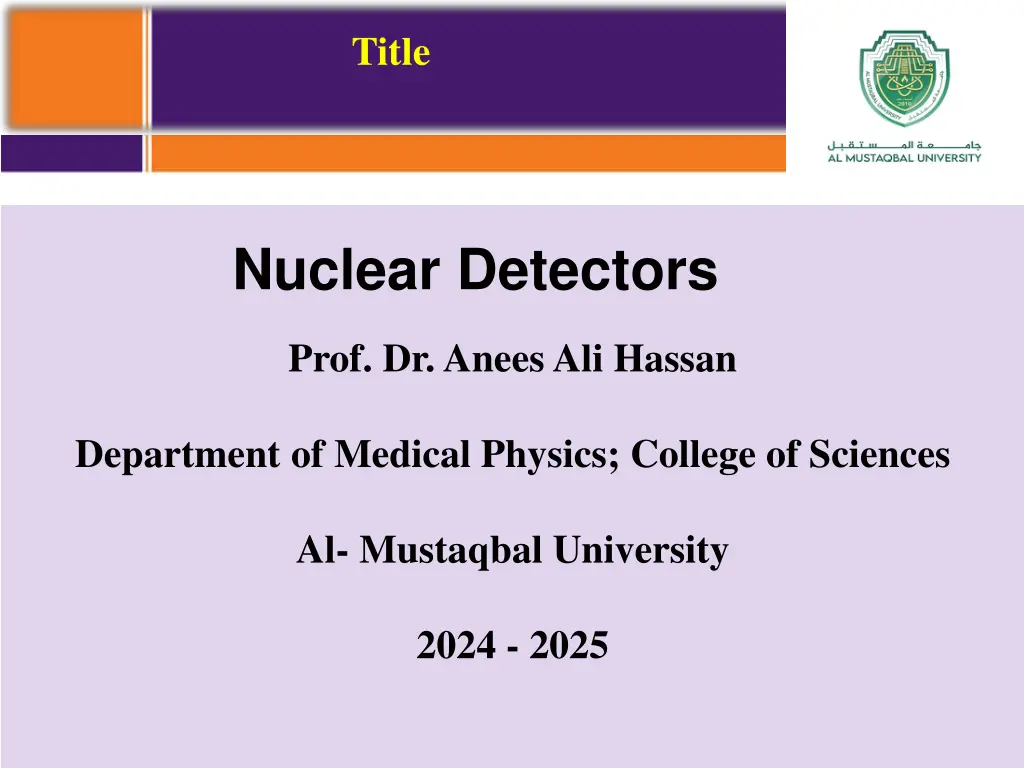
Nuclear Detectors Overview
Explore the world of nuclear detectors with Dr. Anees Ali Hassan from Al-Mustaqbal University. Learn about different types of detectors, modes of operation, detection efficiency, and geometric efficiency. Discover how these detectors interact with matter and the types of interactions they exhibit.
Uploaded on | 0 Views
Download Presentation

Please find below an Image/Link to download the presentation.
The content on the website is provided AS IS for your information and personal use only. It may not be sold, licensed, or shared on other websites without obtaining consent from the author. If you encounter any issues during the download, it is possible that the publisher has removed the file from their server.
You are allowed to download the files provided on this website for personal or commercial use, subject to the condition that they are used lawfully. All files are the property of their respective owners.
The content on the website is provided AS IS for your information and personal use only. It may not be sold, licensed, or shared on other websites without obtaining consent from the author.
E N D
Presentation Transcript
Title Nuclear Detectors Prof. Dr. Anees Ali Hassan Department of Medical Physics; College of Sciences Al- Mustaqbal University 2024 - 2025
Introduction Ionizing radiation is rarely detected directly. Instead, detectors usually measure the secondary products arising from the interactions of the radiation with the detector. There are many types of detectors such as: o Gas-filled detectors consist of a volume of gas between two electrodes o Scintillation detectors, the interaction of ionizing radiation produces visible light. o Semiconductor detectors are especially pure crystals of silicon, germanium, or other materials to which trace amounts of impurity atoms have been added so that they act as diodes. o Personal Dosimeters which is personal and portable to assess the absorbed dose by radiation workers.
Nuclear Detectors Types of detectors (cont.) Detectors may also be classified by the type of information produced: 1. Detectors, such as Geiger-Mueller (GM) detectors, that indicate the number of interactions occurring in the detector are called counters. 2. Detectors that yield information about the energy distribution of the incident radiation, such as NaIscintillation detectors, are called spectrometers. 3. Detectors that indicate the net amount of energy deposited in the detector by multiple interactions are called dosimeters.
Nuclear Detectors Modes of operation In pulse mode, the signal from each interaction is processed individually. In current mode, the electrical signals from individual averaged together, forming a net current signal. interactions are
Nuclear Detectors Detection efficiency The efficiency (sensitivity) of a detector is a measure of its ability to detect radiation. Efficiency of a detection system operated is defined as the probability that a particle or photon emitted by a source will be detected .
Nuclear Detectors Geometric efficiency o The quotient: number of photons reaching the detector over the number of photons emitted from the sample. Number reaching detector = Geometric efficiency Number emitted Increasing geometric efficiency
Gaseous Detectors Overview Interaction with Matter Types of Interactions: Excitation Ionization Media in which the interactions occur: Solid Liquid Gas
Gaseous Detectors Instruments based on the direct collection of the ionization electrons and ions produced in a gas by passing radiation were the first electrical devices developed for radiation detection. Because of the greater mobility of electrons and ions, a gas is the obvious medium to use for the collection of ionization from radiation.
General features of gaseous detectors 1. Rugged and simple to operate. 2. Cheap and easy to maintain. 3. Low density. 4. Inefficientfor gammas 5. Efficient for charged particles and slow neutrons. 6. Higher dead time than solid/liquid detectors.
There are three original gas devices: Ionization chamber, Proportional counter and Geiger Mueller counter, serve as a good illustration of the application of gas ionization phenomena in this class of instruments. These detectors are actually the same device working under different operating parameters.
Gas-Filled Detectors - Components 1. 2. 3. 4. Variable voltage source. Gas-filled counting chamber. Two coaxial electrodes well insulated from each other. Electron-pairs. produced by radiation in fill gas. move under influence of electric field. produce measurable current on electrodes transformed into pulse. .
If radiation now penetrates the cylinder, a certain number of electron-ion pairs will be created, either directly, if the radiation is a charged particle, or indirectly through secondary reactions if the radiation is neutral. As a charged particle passes through a gas, interactions create both excited molecules and ionized molecules along its path. After a neutral molecule is ionized, the resulting positive ion and free electron are called an ion pair and it serves as the basic constituent of the electrical signal developed by the detector. The mean number of pairs created is proportional to the energy deposited in the counter. Under the action of the electric field, the electrons will be accelerated towards the anode and the ions towards the cathode where they are collected. Average value required for creating an electron-ion pair is important since it determines the efficiency and energy resolution of the detector.
W Factor W value (eV/ion pair) Fast Electrons Alphas 30.2 32.2 32.5 35.0 35.8 38.0 Gas CH4 O2 He Air N2 H2 In most gases, the energy needed to ionize the least tightly bound electrons is known as W Factor, the average "energy typically 30 35 eV/ion pair 29.0 32.2 31.7 35.2 36.0 37.0 is
The signal observed depends on the field intensity which is illustrated in the figure which plots the total charge collected as a function of V.






















